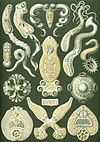User:Abyssal/Portal:Neogene/Natural world articles/29
The flatworms, or Platyhelminthes are a phylum of relatively simple bilaterian, unsegmented, soft-bodied invertebrates. Unlike other bilaterians, they are acoelomates, (having no body cavity), and no specialized circulatory and respiratory organs, which restricts them to having flattened shapes that allow oxygen and nutrients to pass through their bodies by diffusion. The digestive cavity has only one opening for both the ingestion (intake of nutrients) and egestion (removal of undigested wastes); as a result, the food cannot be processed continuously. Over half of all known flatworm species are parasitic. Free-living flatworms are mostly predators, and live in water or in shaded, humid terrestrial environments such as leaf litter.
Analyses since the mid-1980s have separated out one subgroup, the Acoelomorpha, as basal bilaterians (animals with bilateral symmetry and hence with distinct front and rear ends). The remaining Platyhelminthes form a monophyletic group - one that contains all and only descendants of a common ancestor that is itself a member of the group. The redefined Platyhelminthes is part of the Lophotrochozoa, one of the three main groups of more complex bilaterians. These analyses had concluded the redefined Platyhelminthes, excluding Acoelomorpha, consists of two monophyletic subgroups, Catenulida and Rhabditida, with Cestoda, Trematoda and Monogenea forming a monophyletic subgroup within one branch of the Rhabditophora. Hence, the traditional platyhelminth subgroup "Turbellaria" is now regarded as paraphyletic, since it excludes the wholly parasitic groups, although these are descended from one group of "turbellarians". (see more...)

